Time Value of Money Concepts: Application in Financial Management
VerifiedAdded on 2022/11/11
|7
|1966
|125
Essay
AI Summary
This essay explores the application of the time value of money (TVM) concept in various financial management decisions. It begins by defining TVM and its core principles, emphasizing the preference for present money over future money due to its earning potential. The essay discusses key variables in TVM calculations, including present value, future value, interest rate, number of periods, and payment amount. It examines the processes of discounting and compounding, justifying the use of discounting in decision-making. Furthermore, it elaborates on the components of the discount rate, such as the risk-free rate of return and risk premiums, and explains the importance of selecting an appropriate discount rate for different investment projects. The essay also covers the application of TVM in valuing financial instruments like bonds, equity shares, and preference shares, as well as its significance in capital budgeting decisions. It concludes that understanding TVM is crucial for making informed financial decisions in both personal and business contexts.
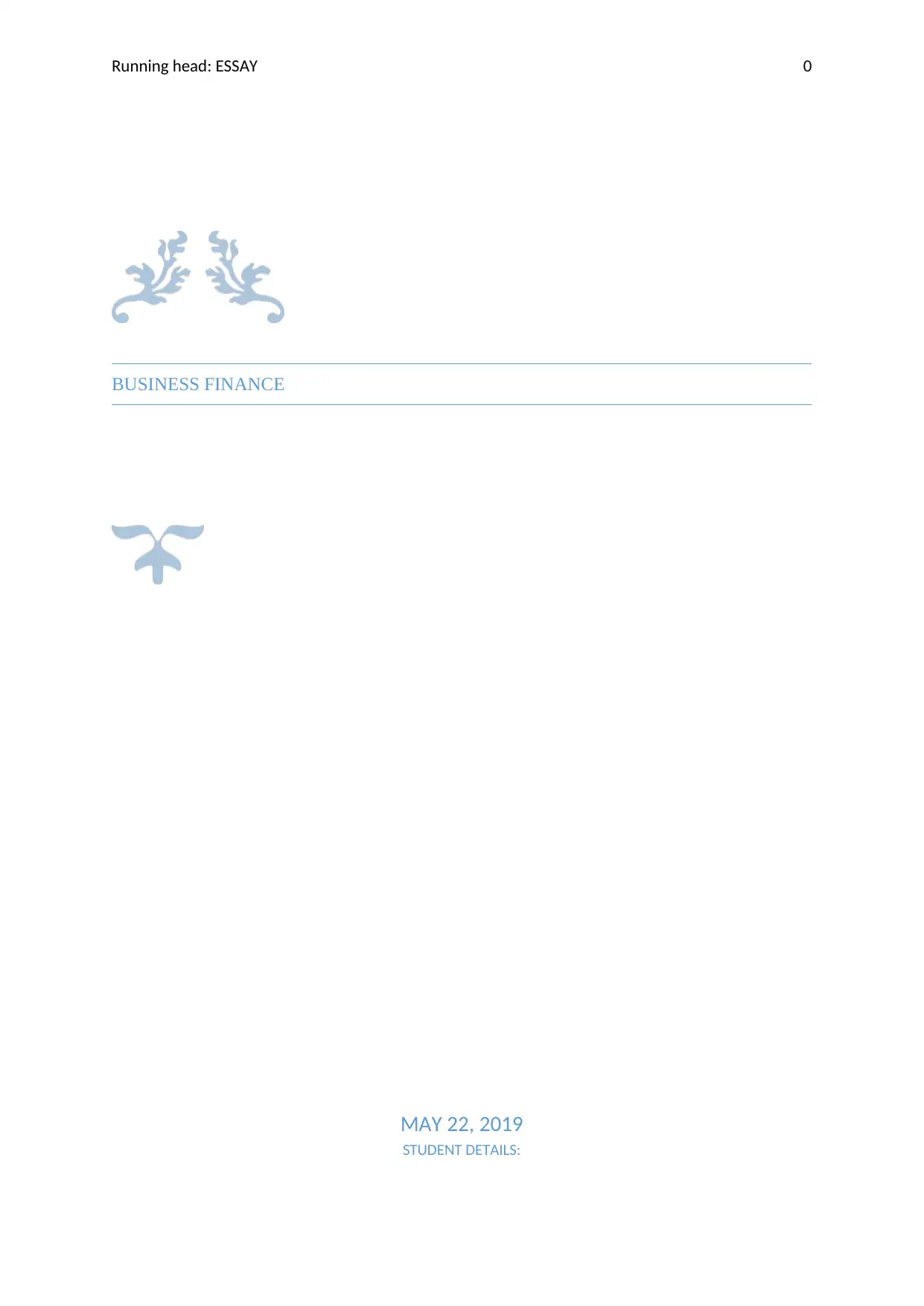
Running head: ESSAY 0
BUSINESS FINANCE
MAY 22, 2019
STUDENT DETAILS:
BUSINESS FINANCE
MAY 22, 2019
STUDENT DETAILS:
Paraphrase This Document
Need a fresh take? Get an instant paraphrase of this document with our AI Paraphraser
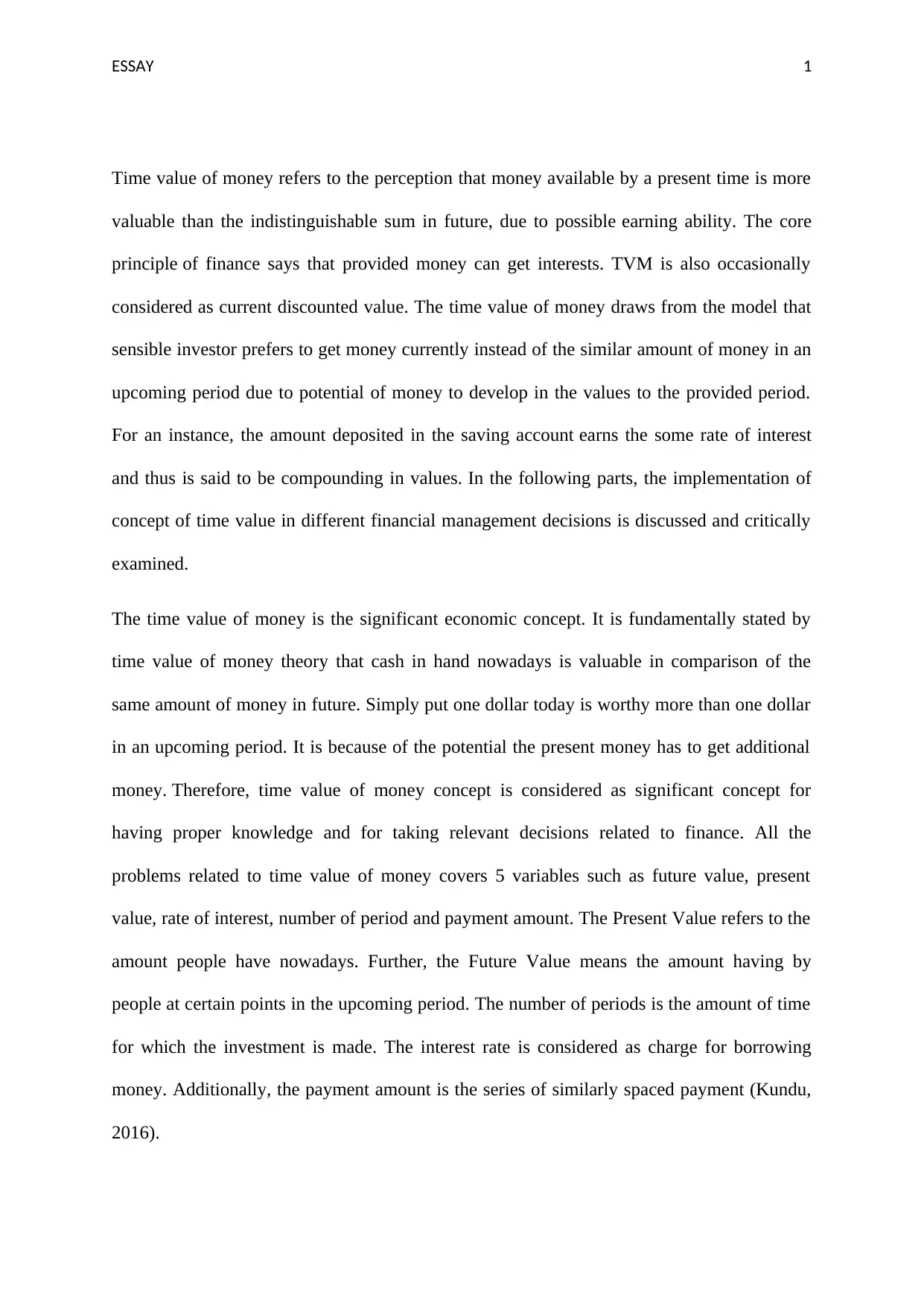
ESSAY 1
Time value of money refers to the perception that money available by a present time is more
valuable than the indistinguishable sum in future, due to possible earning ability. The core
principle of finance says that provided money can get interests. TVM is also occasionally
considered as current discounted value. The time value of money draws from the model that
sensible investor prefers to get money currently instead of the similar amount of money in an
upcoming period due to potential of money to develop in the values to the provided period.
For an instance, the amount deposited in the saving account earns the some rate of interest
and thus is said to be compounding in values. In the following parts, the implementation of
concept of time value in different financial management decisions is discussed and critically
examined.
The time value of money is the significant economic concept. It is fundamentally stated by
time value of money theory that cash in hand nowadays is valuable in comparison of the
same amount of money in future. Simply put one dollar today is worthy more than one dollar
in an upcoming period. It is because of the potential the present money has to get additional
money. Therefore, time value of money concept is considered as significant concept for
having proper knowledge and for taking relevant decisions related to finance. All the
problems related to time value of money covers 5 variables such as future value, present
value, rate of interest, number of period and payment amount. The Present Value refers to the
amount people have nowadays. Further, the Future Value means the amount having by
people at certain points in the upcoming period. The number of periods is the amount of time
for which the investment is made. The interest rate is considered as charge for borrowing
money. Additionally, the payment amount is the series of similarly spaced payment (Kundu,
2016).
Time value of money refers to the perception that money available by a present time is more
valuable than the indistinguishable sum in future, due to possible earning ability. The core
principle of finance says that provided money can get interests. TVM is also occasionally
considered as current discounted value. The time value of money draws from the model that
sensible investor prefers to get money currently instead of the similar amount of money in an
upcoming period due to potential of money to develop in the values to the provided period.
For an instance, the amount deposited in the saving account earns the some rate of interest
and thus is said to be compounding in values. In the following parts, the implementation of
concept of time value in different financial management decisions is discussed and critically
examined.
The time value of money is the significant economic concept. It is fundamentally stated by
time value of money theory that cash in hand nowadays is valuable in comparison of the
same amount of money in future. Simply put one dollar today is worthy more than one dollar
in an upcoming period. It is because of the potential the present money has to get additional
money. Therefore, time value of money concept is considered as significant concept for
having proper knowledge and for taking relevant decisions related to finance. All the
problems related to time value of money covers 5 variables such as future value, present
value, rate of interest, number of period and payment amount. The Present Value refers to the
amount people have nowadays. Further, the Future Value means the amount having by
people at certain points in the upcoming period. The number of periods is the amount of time
for which the investment is made. The interest rate is considered as charge for borrowing
money. Additionally, the payment amount is the series of similarly spaced payment (Kundu,
2016).
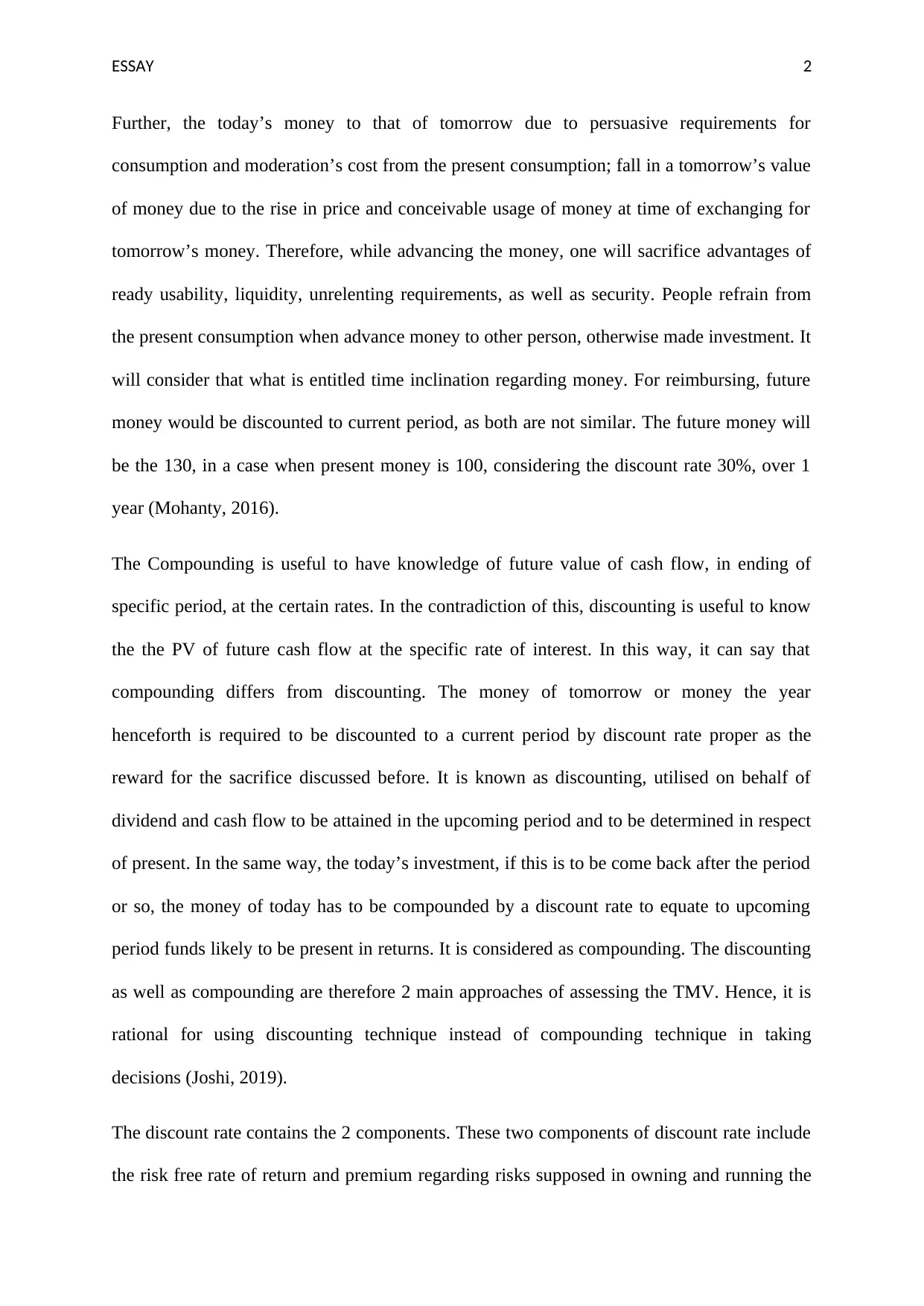
ESSAY 2
Further, the today’s money to that of tomorrow due to persuasive requirements for
consumption and moderation’s cost from the present consumption; fall in a tomorrow’s value
of money due to the rise in price and conceivable usage of money at time of exchanging for
tomorrow’s money. Therefore, while advancing the money, one will sacrifice advantages of
ready usability, liquidity, unrelenting requirements, as well as security. People refrain from
the present consumption when advance money to other person, otherwise made investment. It
will consider that what is entitled time inclination regarding money. For reimbursing, future
money would be discounted to current period, as both are not similar. The future money will
be the 130, in a case when present money is 100, considering the discount rate 30%, over 1
year (Mohanty, 2016).
The Compounding is useful to have knowledge of future value of cash flow, in ending of
specific period, at the certain rates. In the contradiction of this, discounting is useful to know
the the PV of future cash flow at the specific rate of interest. In this way, it can say that
compounding differs from discounting. The money of tomorrow or money the year
henceforth is required to be discounted to a current period by discount rate proper as the
reward for the sacrifice discussed before. It is known as discounting, utilised on behalf of
dividend and cash flow to be attained in the upcoming period and to be determined in respect
of present. In the same way, the today’s investment, if this is to be come back after the period
or so, the money of today has to be compounded by a discount rate to equate to upcoming
period funds likely to be present in returns. It is considered as compounding. The discounting
as well as compounding are therefore 2 main approaches of assessing the TMV. Hence, it is
rational for using discounting technique instead of compounding technique in taking
decisions (Joshi, 2019).
The discount rate contains the 2 components. These two components of discount rate include
the risk free rate of return and premium regarding risks supposed in owning and running the
Further, the today’s money to that of tomorrow due to persuasive requirements for
consumption and moderation’s cost from the present consumption; fall in a tomorrow’s value
of money due to the rise in price and conceivable usage of money at time of exchanging for
tomorrow’s money. Therefore, while advancing the money, one will sacrifice advantages of
ready usability, liquidity, unrelenting requirements, as well as security. People refrain from
the present consumption when advance money to other person, otherwise made investment. It
will consider that what is entitled time inclination regarding money. For reimbursing, future
money would be discounted to current period, as both are not similar. The future money will
be the 130, in a case when present money is 100, considering the discount rate 30%, over 1
year (Mohanty, 2016).
The Compounding is useful to have knowledge of future value of cash flow, in ending of
specific period, at the certain rates. In the contradiction of this, discounting is useful to know
the the PV of future cash flow at the specific rate of interest. In this way, it can say that
compounding differs from discounting. The money of tomorrow or money the year
henceforth is required to be discounted to a current period by discount rate proper as the
reward for the sacrifice discussed before. It is known as discounting, utilised on behalf of
dividend and cash flow to be attained in the upcoming period and to be determined in respect
of present. In the same way, the today’s investment, if this is to be come back after the period
or so, the money of today has to be compounded by a discount rate to equate to upcoming
period funds likely to be present in returns. It is considered as compounding. The discounting
as well as compounding are therefore 2 main approaches of assessing the TMV. Hence, it is
rational for using discounting technique instead of compounding technique in taking
decisions (Joshi, 2019).
The discount rate contains the 2 components. These two components of discount rate include
the risk free rate of return and premium regarding risks supposed in owning and running the
⊘ This is a preview!⊘
Do you want full access?
Subscribe today to unlock all pages.

Trusted by 1+ million students worldwide
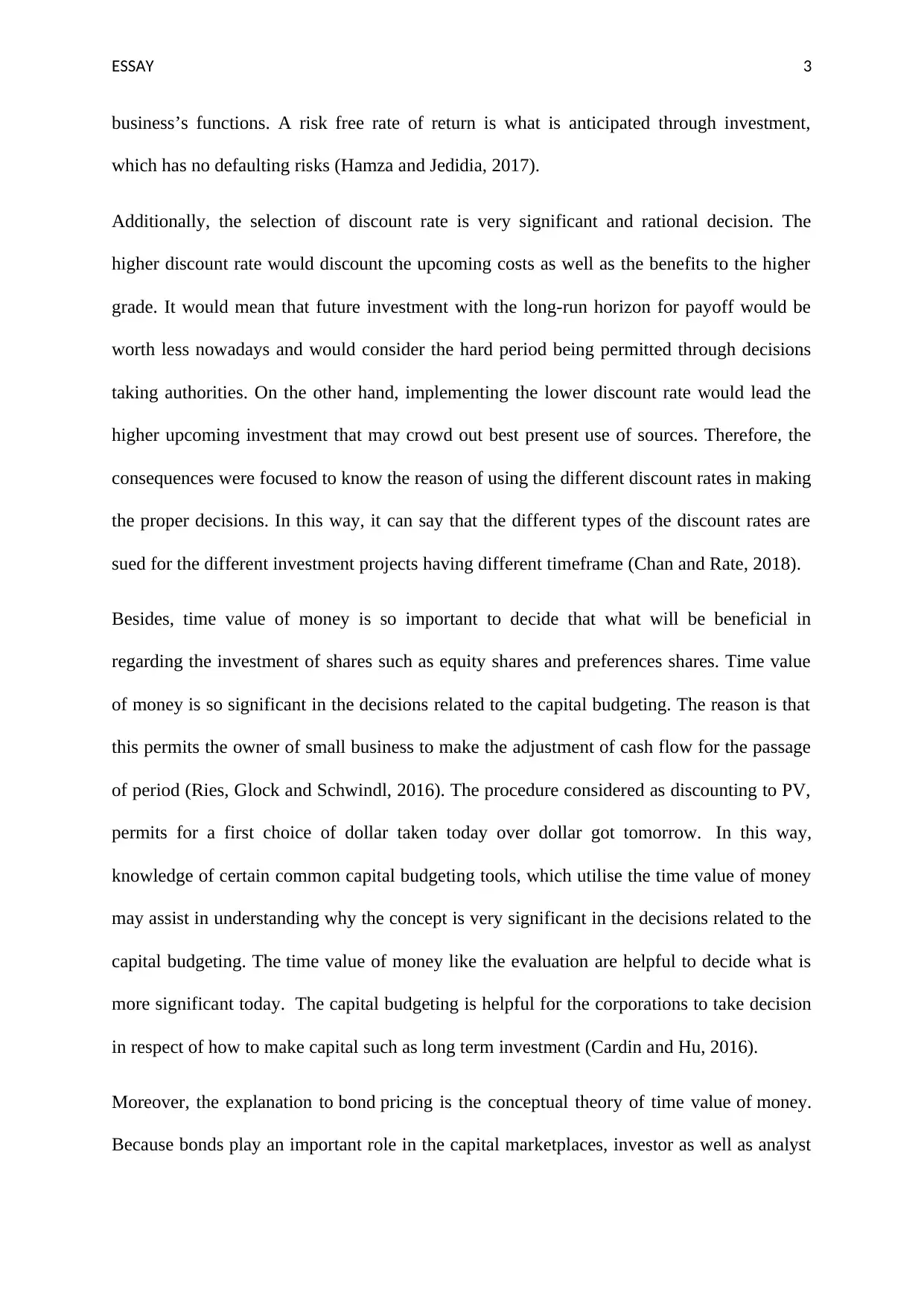
ESSAY 3
business’s functions. A risk free rate of return is what is anticipated through investment,
which has no defaulting risks (Hamza and Jedidia, 2017).
Additionally, the selection of discount rate is very significant and rational decision. The
higher discount rate would discount the upcoming costs as well as the benefits to the higher
grade. It would mean that future investment with the long-run horizon for payoff would be
worth less nowadays and would consider the hard period being permitted through decisions
taking authorities. On the other hand, implementing the lower discount rate would lead the
higher upcoming investment that may crowd out best present use of sources. Therefore, the
consequences were focused to know the reason of using the different discount rates in making
the proper decisions. In this way, it can say that the different types of the discount rates are
sued for the different investment projects having different timeframe (Chan and Rate, 2018).
Besides, time value of money is so important to decide that what will be beneficial in
regarding the investment of shares such as equity shares and preferences shares. Time value
of money is so significant in the decisions related to the capital budgeting. The reason is that
this permits the owner of small business to make the adjustment of cash flow for the passage
of period (Ries, Glock and Schwindl, 2016). The procedure considered as discounting to PV,
permits for a first choice of dollar taken today over dollar got tomorrow. In this way,
knowledge of certain common capital budgeting tools, which utilise the time value of money
may assist in understanding why the concept is very significant in the decisions related to the
capital budgeting. The time value of money like the evaluation are helpful to decide what is
more significant today. The capital budgeting is helpful for the corporations to take decision
in respect of how to make capital such as long term investment (Cardin and Hu, 2016).
Moreover, the explanation to bond pricing is the conceptual theory of time value of money.
Because bonds play an important role in the capital marketplaces, investor as well as analyst
business’s functions. A risk free rate of return is what is anticipated through investment,
which has no defaulting risks (Hamza and Jedidia, 2017).
Additionally, the selection of discount rate is very significant and rational decision. The
higher discount rate would discount the upcoming costs as well as the benefits to the higher
grade. It would mean that future investment with the long-run horizon for payoff would be
worth less nowadays and would consider the hard period being permitted through decisions
taking authorities. On the other hand, implementing the lower discount rate would lead the
higher upcoming investment that may crowd out best present use of sources. Therefore, the
consequences were focused to know the reason of using the different discount rates in making
the proper decisions. In this way, it can say that the different types of the discount rates are
sued for the different investment projects having different timeframe (Chan and Rate, 2018).
Besides, time value of money is so important to decide that what will be beneficial in
regarding the investment of shares such as equity shares and preferences shares. Time value
of money is so significant in the decisions related to the capital budgeting. The reason is that
this permits the owner of small business to make the adjustment of cash flow for the passage
of period (Ries, Glock and Schwindl, 2016). The procedure considered as discounting to PV,
permits for a first choice of dollar taken today over dollar got tomorrow. In this way,
knowledge of certain common capital budgeting tools, which utilise the time value of money
may assist in understanding why the concept is very significant in the decisions related to the
capital budgeting. The time value of money like the evaluation are helpful to decide what is
more significant today. The capital budgeting is helpful for the corporations to take decision
in respect of how to make capital such as long term investment (Cardin and Hu, 2016).
Moreover, the explanation to bond pricing is the conceptual theory of time value of money.
Because bonds play an important role in the capital marketplaces, investor as well as analyst
Paraphrase This Document
Need a fresh take? Get an instant paraphrase of this document with our AI Paraphraser
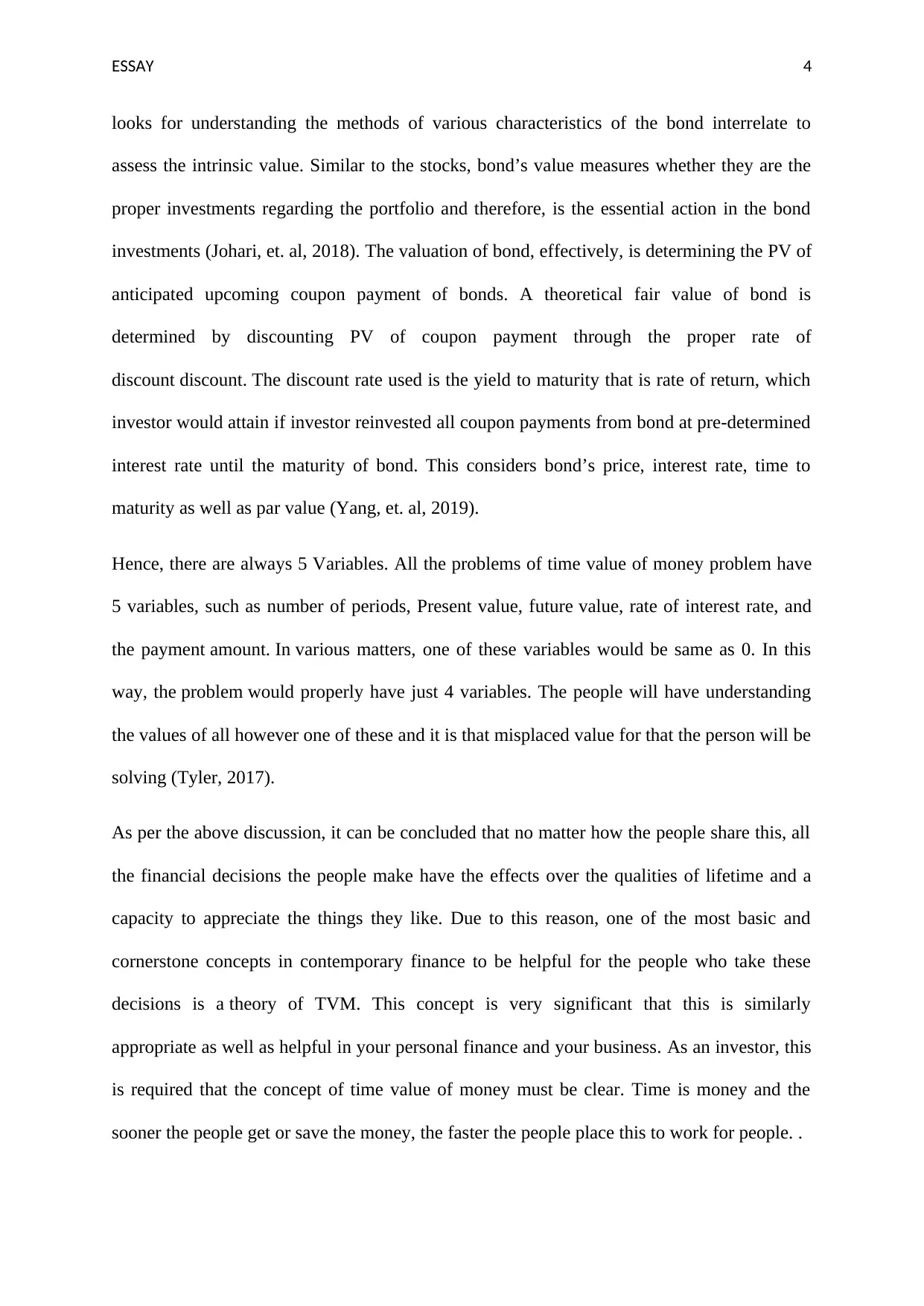
ESSAY 4
looks for understanding the methods of various characteristics of the bond interrelate to
assess the intrinsic value. Similar to the stocks, bond’s value measures whether they are the
proper investments regarding the portfolio and therefore, is the essential action in the bond
investments (Johari, et. al, 2018). The valuation of bond, effectively, is determining the PV of
anticipated upcoming coupon payment of bonds. A theoretical fair value of bond is
determined by discounting PV of coupon payment through the proper rate of
discount discount. The discount rate used is the yield to maturity that is rate of return, which
investor would attain if investor reinvested all coupon payments from bond at pre-determined
interest rate until the maturity of bond. This considers bond’s price, interest rate, time to
maturity as well as par value (Yang, et. al, 2019).
Hence, there are always 5 Variables. All the problems of time value of money problem have
5 variables, such as number of periods, Present value, future value, rate of interest rate, and
the payment amount. In various matters, one of these variables would be same as 0. In this
way, the problem would properly have just 4 variables. The people will have understanding
the values of all however one of these and it is that misplaced value for that the person will be
solving (Tyler, 2017).
As per the above discussion, it can be concluded that no matter how the people share this, all
the financial decisions the people make have the effects over the qualities of lifetime and a
capacity to appreciate the things they like. Due to this reason, one of the most basic and
cornerstone concepts in contemporary finance to be helpful for the people who take these
decisions is a theory of TVM. This concept is very significant that this is similarly
appropriate as well as helpful in your personal finance and your business. As an investor, this
is required that the concept of time value of money must be clear. Time is money and the
sooner the people get or save the money, the faster the people place this to work for people. .
looks for understanding the methods of various characteristics of the bond interrelate to
assess the intrinsic value. Similar to the stocks, bond’s value measures whether they are the
proper investments regarding the portfolio and therefore, is the essential action in the bond
investments (Johari, et. al, 2018). The valuation of bond, effectively, is determining the PV of
anticipated upcoming coupon payment of bonds. A theoretical fair value of bond is
determined by discounting PV of coupon payment through the proper rate of
discount discount. The discount rate used is the yield to maturity that is rate of return, which
investor would attain if investor reinvested all coupon payments from bond at pre-determined
interest rate until the maturity of bond. This considers bond’s price, interest rate, time to
maturity as well as par value (Yang, et. al, 2019).
Hence, there are always 5 Variables. All the problems of time value of money problem have
5 variables, such as number of periods, Present value, future value, rate of interest rate, and
the payment amount. In various matters, one of these variables would be same as 0. In this
way, the problem would properly have just 4 variables. The people will have understanding
the values of all however one of these and it is that misplaced value for that the person will be
solving (Tyler, 2017).
As per the above discussion, it can be concluded that no matter how the people share this, all
the financial decisions the people make have the effects over the qualities of lifetime and a
capacity to appreciate the things they like. Due to this reason, one of the most basic and
cornerstone concepts in contemporary finance to be helpful for the people who take these
decisions is a theory of TVM. This concept is very significant that this is similarly
appropriate as well as helpful in your personal finance and your business. As an investor, this
is required that the concept of time value of money must be clear. Time is money and the
sooner the people get or save the money, the faster the people place this to work for people. .
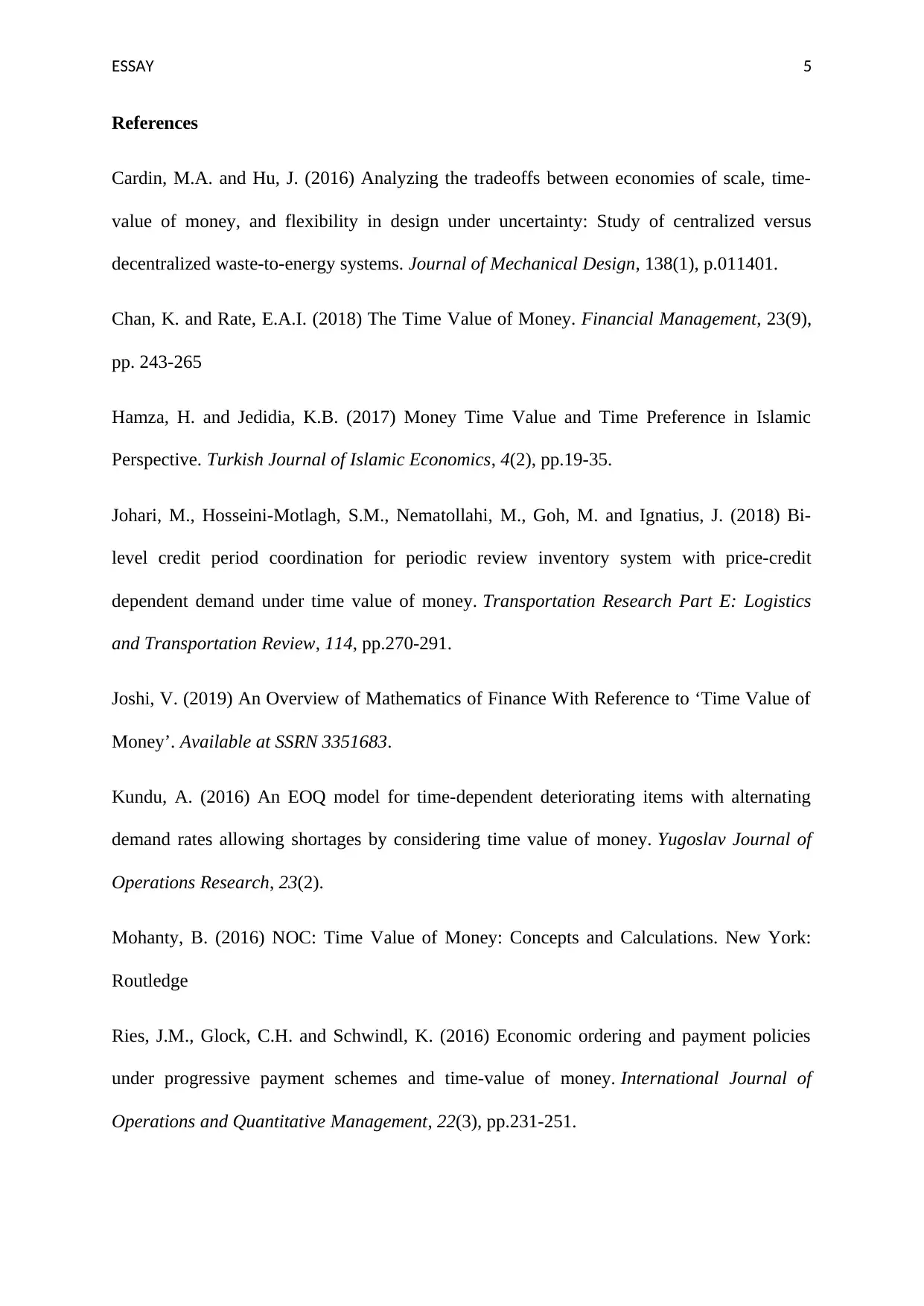
ESSAY 5
References
Cardin, M.A. and Hu, J. (2016) Analyzing the tradeoffs between economies of scale, time-
value of money, and flexibility in design under uncertainty: Study of centralized versus
decentralized waste-to-energy systems. Journal of Mechanical Design, 138(1), p.011401.
Chan, K. and Rate, E.A.I. (2018) The Time Value of Money. Financial Management, 23(9),
pp. 243-265
Hamza, H. and Jedidia, K.B. (2017) Money Time Value and Time Preference in Islamic
Perspective. Turkish Journal of Islamic Economics, 4(2), pp.19-35.
Johari, M., Hosseini-Motlagh, S.M., Nematollahi, M., Goh, M. and Ignatius, J. (2018) Bi-
level credit period coordination for periodic review inventory system with price-credit
dependent demand under time value of money. Transportation Research Part E: Logistics
and Transportation Review, 114, pp.270-291.
Joshi, V. (2019) An Overview of Mathematics of Finance With Reference to ‘Time Value of
Money’. Available at SSRN 3351683.
Kundu, A. (2016) An EOQ model for time-dependent deteriorating items with alternating
demand rates allowing shortages by considering time value of money. Yugoslav Journal of
Operations Research, 23(2).
Mohanty, B. (2016) NOC: Time Value of Money: Concepts and Calculations. New York:
Routledge
Ries, J.M., Glock, C.H. and Schwindl, K. (2016) Economic ordering and payment policies
under progressive payment schemes and time-value of money. International Journal of
Operations and Quantitative Management, 22(3), pp.231-251.
References
Cardin, M.A. and Hu, J. (2016) Analyzing the tradeoffs between economies of scale, time-
value of money, and flexibility in design under uncertainty: Study of centralized versus
decentralized waste-to-energy systems. Journal of Mechanical Design, 138(1), p.011401.
Chan, K. and Rate, E.A.I. (2018) The Time Value of Money. Financial Management, 23(9),
pp. 243-265
Hamza, H. and Jedidia, K.B. (2017) Money Time Value and Time Preference in Islamic
Perspective. Turkish Journal of Islamic Economics, 4(2), pp.19-35.
Johari, M., Hosseini-Motlagh, S.M., Nematollahi, M., Goh, M. and Ignatius, J. (2018) Bi-
level credit period coordination for periodic review inventory system with price-credit
dependent demand under time value of money. Transportation Research Part E: Logistics
and Transportation Review, 114, pp.270-291.
Joshi, V. (2019) An Overview of Mathematics of Finance With Reference to ‘Time Value of
Money’. Available at SSRN 3351683.
Kundu, A. (2016) An EOQ model for time-dependent deteriorating items with alternating
demand rates allowing shortages by considering time value of money. Yugoslav Journal of
Operations Research, 23(2).
Mohanty, B. (2016) NOC: Time Value of Money: Concepts and Calculations. New York:
Routledge
Ries, J.M., Glock, C.H. and Schwindl, K. (2016) Economic ordering and payment policies
under progressive payment schemes and time-value of money. International Journal of
Operations and Quantitative Management, 22(3), pp.231-251.
⊘ This is a preview!⊘
Do you want full access?
Subscribe today to unlock all pages.

Trusted by 1+ million students worldwide

ESSAY 6
Tyler, B.D. (2017) Using the time value of money decision tree to calculate an athlete’s
contract offers. Case Studies in Sport Management, 6(1), pp.48-57.
Yang, D., Jiang, M., Chen, Z. and Nie, P. (2019) Analysis on one-off subsidy for renewable
energy projects based on time value of money. Journal of Renewable and Sustainable
Energy, 11(2), p.025901.
Tyler, B.D. (2017) Using the time value of money decision tree to calculate an athlete’s
contract offers. Case Studies in Sport Management, 6(1), pp.48-57.
Yang, D., Jiang, M., Chen, Z. and Nie, P. (2019) Analysis on one-off subsidy for renewable
energy projects based on time value of money. Journal of Renewable and Sustainable
Energy, 11(2), p.025901.
1 out of 7
Related Documents
Your All-in-One AI-Powered Toolkit for Academic Success.
+13062052269
info@desklib.com
Available 24*7 on WhatsApp / Email
![[object Object]](/_next/static/media/star-bottom.7253800d.svg)
Unlock your academic potential
Copyright © 2020–2025 A2Z Services. All Rights Reserved. Developed and managed by ZUCOL.





